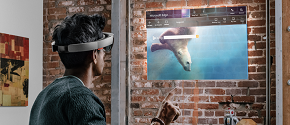
Highlights of Microsoft at London Tech Week’s TechXLR8
If being around the latest trends in technology – topics such as artificial intelligence, mixed reality and IoT – is exciting to you, then last week’s TechXLR8 probably had you feeling like a kid in a sweetie store. For those of you who missed it, though, here’s a quick wrap-up of some of the great moments that had the ExCel buzzing.
Mixed reality: from high altitude to high fashion
Peter Daukintis, Tech Evangelist at Microsoft, gave an overview of the spectrum of mixed reality from the fully physical to the fully digital and everything in between. From there he showed how Microsoft and our partners are using the Windows Mixed Reality platform to develop new apps that range from augmented to fully immersive experiences. He then gave a breakdown of the HoloLens from transparent 3D lenses to, spatial sound to the holographic processing unit. Seeing how much tech has been fit into such a small space, it really gives one an appreciation for just how sophisticated the world’s first self-contained, holographic computer actually is.
While the technology itself was interesting, it was the practical applications of HoloLens, from real-world organisations, that I found fascinating. Connie Miller, Space Exploration Information Technology Application Development Lead for Boeing, for instance, described how the HoloLens is helping them develop new processes and solutions for the International Space Station. This includes becoming more efficient at training, design review, and interface testing. It’s also allowing them to envision and simulate scenarios that are difficult to replicate on earth. Practical considerations such as whether or not an astronaut – who may be working upside down – can fit a water storage valve into the station’s existing space.
In walking around the exhibit floor, I came across a more earth-bound (though some may say equally far-out) application for HoloLens developed by DoubleMe and fashion designer Martine Jarlgaard. Together, they created one of the world’s first mixed-reality fashion shows at London Fashion Week.
Take a look at their story here:
Making the Business Case for IoT
As is often the case with emerging digital technology – companies can find themselves experimenting through pilots that never end up returning real business benefit. To help overcome that, Microsoft’s Patrick Ward discussed several key areas where the Internet of Things (IoT) drives business value, and a framework for how customers can plan and measure success. The first of the five areas is around cost reduction; the kind companies can achieve through improved service planning, or smarter machine utilisation to prevent machine or system failure. A second area for business value was the creation of new revenue opportunities; for example, a windscreen wiper manufacturer providing real-time wiper data to better pinpoint, measure and predict localised changes in weather. Other business benefits included better customer insights (for things like warranty claim validation), product improvement and reliability (e.g., feeding data back into the development process), and brand (e.g., being associated with innovation or product reliability). An example that brings many of these benefits together is Schneider Electric, who are using IoT to bring reliable and sustainable solar power to remote parts Nigeria.
Watch Schneider’s Story here
https://youtube.com/watch?v=dQkNHJz-CXI
AI: Humans and Machines (well, algorithms really)
Another big topic covered at TechXLR8 was artificial intelligence, and while it overlaps with most of the other disruptive tech covered at the event, Dr Rob Fraser, Senior Director Technical Evangelism, gave context to the confluence of technologies that have led to the current state of AI, where it’s going, and what implications that might have. At its heart, Rob points out, AI is about the intersection of big compute (the increasing processing power available to people and organisations), increasingly powerful algorithms (like deep nets) and the proliferation of data (not just big, but massive data) made possible by the intelligent cloud. Together this combination of technology is powering breakthroughs in image recognition and natural language processing. Even though the cloud is a key part of making AI possible, Rob also talked about AI on the intelligent edge – where sophisticated AI can happen with or without cloud connected computing.
While the technology behind AI was interesting, I was even more interested in the way Rob talked about the human impact of AI. He provided examples such as the Cochrane Transform Project, where researchers can use artificial intelligence to give time back to healthcare researchers – letting them spend less time processing information, and more time finding meaning in the data to help save and improve lives. He also shared the example of InnerEye Assistive AI for Cancer, a Microsoft-enabled research project using image analysis and tools to dramatically lower the amount of time it takes a skilled clinician to assess the size and growth of tumours in a patient.
And while AI can provide tremendous benefits to humanity, Rob also touched on the fears we have of how it could – if not used correctly – displace humans. But rather than displace humans, Rob discussed the ways that AI can amplify what humans do: amplifying human ingenuity and accelerating business growth. In short AI enables us to amplify on what Rob calls the unique human capital: accountability, creativity, empathy, passion, commitment.
See more on how InnerEye is helping fight cancer
This was just a small sliver of the kind of what Microsoft had on at London Tech Week. To find out more about innovation at Microsoft, and our continuing coverage of the technology landscape, visit our Digital Transformation Hub.




